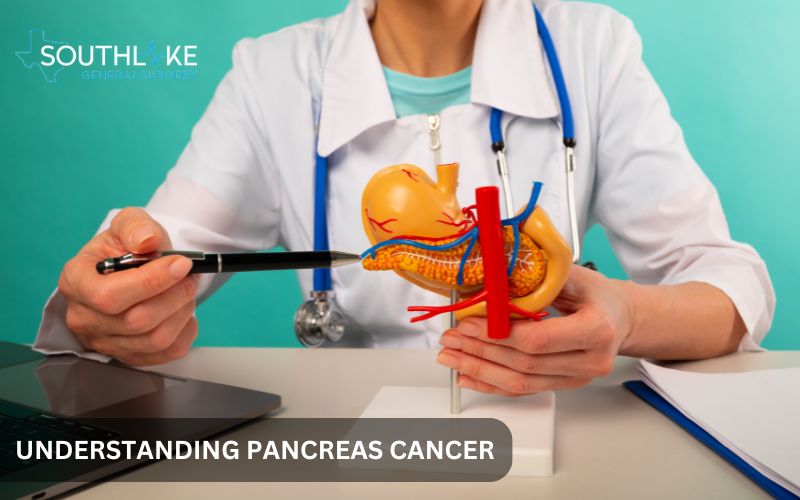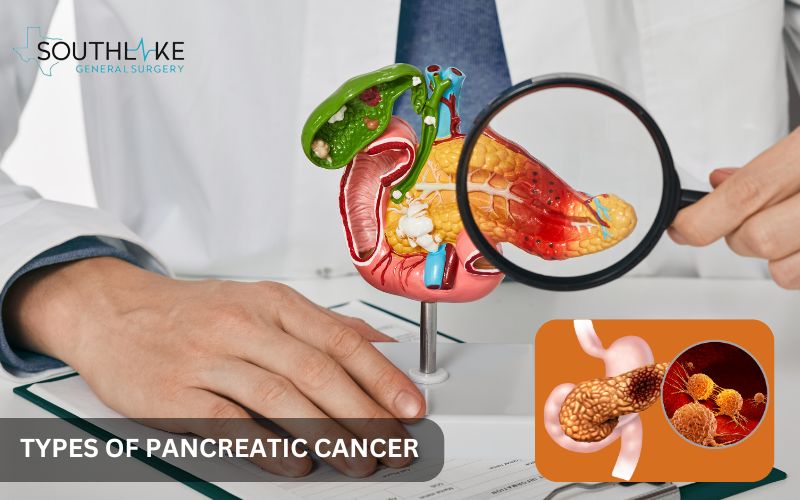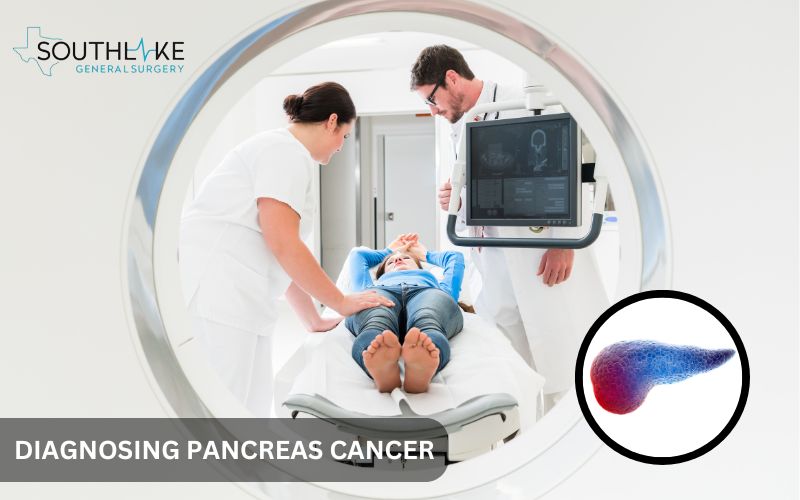Pancreas cancer is a tough illness. It occurs when pancreatic cells begin to proliferate rapidly and uncontrollably. However, the symptoms of pancreatic cancer can be slightly difficult to see, and it might not show up easily in your body. This complicates the identification of the disease during its initial phases.
Key Highlights
- When pancreatic cells begin to proliferate uncontrollably, a disease known as pancreatic cancer occurs. The signs can be unclear. People may feel belly or back pain, lose weight, or have yellow skin.
- There are a few things that can raise the chances of getting this cancer. These include being older, smoking, having diabetes, a family history of cancer, and certain genetic conditions.
- There are a variety of tests that doctors perform to identify pancreatic cancer. These tests include imaging techniques such as CT scans and MRI scans. They may also do endoscopic ultrasounds, blood tests, and biopsies.
- The treatment options depend on where the cancer is and how advanced it is. Treatments may involve surgery, chemotherapy, radiation therapy, or a mix of these.
- While pancreatic cancer has a lower survival rate than many other cancers, catching it early can improve treatment success and give a better chance for a cure.
Understanding Pancreas Cancer

The pancreas helps with digestion by producing enzymes. It also controls blood sugar levels. Even though the pancreas is deep in the abdomen, it is important to find problems early. If pancreatic cancer is found late, it can spread to nearby organs before you see any symptoms.
What is Pancreas Cancer?
Pancreas cancer develops when pancreatic cells mutate and proliferate uncontrollably. These abnormal cells may create tumors that affect the function of the pancreas.
The pancreas is an essential pancreatic organ located in the abdomen between the stomach and the spine. This process helps digestion through the action of enzymes and hormones that play a key role in regulating our blood sugar levels.
There are different types of pancreatic cancer, each with special features and effects. By knowing these types of pancreatic cancer, doctors can create better treatment plans, which help improve patients’ results.
Certain forms of pancreatic cancer originate in the cells responsible for generating digestive enzymes. Other types begin in the cells that create hormones. This shows that pancreatic cancer is very complex. It also explains why it is important to get the right diagnosis.
Types of Pancreatic Cancer

There are two main subtypes of pancreatic cancer that we recognize:
- Pancreatic Adenocarcinoma (Exocrine Tumors): It is the most common type of pancreatic cancer among individuals. Approximately 90% of pancreatic cancers are exocrine tumors. Exocrine tumors are the fastest-growing type of cancer, primarily originating in the cells lining the pancreatic ducts. These ducts help move digestive enzymes in the body.
- Neuroendocrine tumors (NETs): It’s another unique type of pancreatic cancer, found in about 10% of cases of pancreatic cancer and it is also known as Islet cell carcinoma. These tumors originate from pancreatic cells responsible for hormone production. They typically develop at a gradual pace and require specific treatment.
Recognizing the Symptoms of Pancreas Cancer
In the early stages, pancreatic cancer often doesn’t really show any clear signs. The tumor might start pushing on the organs around it when it gets bigger. This pressure may lead to unclear signs that people usually overlook.
These signs can feel like symptoms of other, less serious issues. Because these symptoms are often mild, pancreatic cancer is commonly diagnosed at a later stage. This makes treatment more difficult.
Early Signs to Watch For Pancreas Cancer

The early signs or symptoms of pancreatic cancer often do not appear. However, individuals need to look for possible signs. Some people might notice very minor changes that seem unrelated to the pancreas. Still, these changes can’t be ignored and could need your attention.
- A common sign to notice is unexpected weight loss. A growing tumor can use up more energy from the body. This means you could lose weight without changing your diet or workouts.
- Pay attention to any changes in your bathroom routines. New fatty stools or diarrhea can be a sign because the pancreas plays a crucial role in digesting food.
- Jaundice is another symptom to watch for. This condition leads to a yellow tint in the skin and eyes. This could mean there’s a problem with the bile duct. The problem can arise if the bile flow is blocked due to a tumor in the pancreatic head.
- A sudden development of diabetes can also be an early warning, especially in people who do not have typical risk factors.
You may also encounter the following pancreatic symptoms:
- Pain in the upper abdomen
- Dark color urine
- Skin irritation
- Bloating or gas
- Weight loss
- Fatigue
- Light-colored stools
- Nausea and vomiting
Symptoms That Indicate Advanced Disease
As pancreatic cancer gets worse, you might start to see more obvious symptoms, including:
- Abdominal pain that persists can sometimes spread to the back area. This often happens after you eat or when you are lying down. The tumor exerts pressure on the surrounding nerves, which is why this occurs.
- You could experience nausea and possibly vomit. Your bowel habits could also change. This occurs because the tumor impacts the digestive system.
- The legs are the most common sites for blood clots to develop. This signals that the disease is advanced. Blood clotting factors may be enhanced by substances produced by pancreatic cancer cells. This raises the risk of deep vein thrombosis and other clot issues.
Risk Factors and Causes
The causes of pancreatic cancer are not completely clear. Researchers are trying their best to find the exact causes of pancreatic cancer. However, they found a couple of risk factors which include:
- Age: It is one of them and risk increases after the age of 50.
- Smoking
- Family history
- Chronic pancreatitis
- Diabetes
- Obesity
A few of them are genetic factors that can’t be changed. However, you can choose to have a healthy lifestyle like quitting smoking to reduce the risk.
Genetic Predispositions and Lifestyle Factors
The probability of developing pancreatic cancer can be influenced by genetic factors. Your risk of developing pancreatic cancer increases if you have a personal or close relative who has the disease. Some gene changes, like BRCA1 and BRCA2, related to other cancers can also raise the chance of getting pancreatic cancer.
- The you make every day can influence the risk of pancreatic cancer.
- Smoking negatively impacts the pancreas and contributes to the growth of cancer cells.
- Maintaining a healthy weight is important, and this can be achieved by eating nutritious foods and staying active.
- Being overweight increases your risk.
- The foods you choose to eat may influence your risk of developing pancreatic cancer.
- Not adding enough fruits and vegetables to your diet can lead to various health problems.
- Avoid eating red and processed meat.
Making a few simple yet effective changes to your lifestyle can help lower the risk of developing pancreatic cancer.
Environmental Influences on Pancreas Cancer Risk
Lifestyle and genetics are very important. However, the environment can change the risk of pancreatic cancer too. Being around pesticides and industrial chemicals, especially at work, is connected to a higher chance of getting this disease.
The persistent swelling of the pancreas is a symptom of chronic pancreatitis. It usually happens from drinking too much alcohol or having gallstones. This condition can increase the chances of getting pancreatic cancer.
We can lower the overall risk by looking at environmental factors and dealing with issues like chronic pancreatitis.
Diagnosing Pancreas Cancer
Diagnosing pancreatic cancer is difficult. This is mostly because early symptoms are often missing. When symptoms appear, they can be vague and mistaken for other problems.
This difficulty makes it hard to catch pancreatic cancer early. To confirm a pancreatic cancer diagnosis, doctors use several tests and take samples.
Common Diagnostic Tests and Procedures

- When your doctor suspects there may be pancreatic cancer, they generally recommend you for some tests such as CT scans or an MRI. These tests give your doctor valuable insights about the pancreas and its surrounding areas.
- Your doctor can also advise you to have an endoscopic ultrasound (EUS) for a clear view. In this test, a thin tube with an ultrasound probe is gently inserted through the mouth to capture clear images of the pancreas.
- Doctors may also conduct biopsy during the EUS procedure. A small sample of tissue is taken from the area that appears unusual. This process can assist in identifying cancer cells and understanding the type and grade of the tumor.
The Importance of Early Detection
Early detection can help people survive pancreatic cancer. When doctors catch cancer in the early stages and it hasn’t spread beyond the pancreas, surgery may cure the disease.
The Whipple procedure is a good option. The removal of the pancreatic head is a challenging surgical procedure. This is the area where many tumors occur. Having this surgery offers the best chance to cure cancer at this point.
Sadly, many pancreatic cancers are found in later stages. During this period, the tumor frequently spreads, making it difficult to treat, and diminishing the possibility of fully recovering.
Stages of Pancreas Cancer
Understanding the stages of pancreatic cancer is essential for every individual. It helps us to choose the right treatment and understand the outlook for the disease.
Staging determines the extent to which the tumor has metastasized to other organs and tissues inside the body. It divides the cancer into several stages, ranging from localized to metastatic.
From Localized to Metastatic: Understanding the Stages
Pancreatic cancer staging often uses the TNM system. TNM means:
- T (Tumor): This provides information about the size of the main tumor and its growth in the surrounding area.
- N (Nodes): It indicates whether the cancer has spread to nearby lymph nodes.
- M (Metastasis): This means that the cancer has spread to other areas of the body.
In summary:
- Stage 0: The pancreatic duct lining contains aberrant cells, but they have not yet metastasized.
- Stage I: At this initial stage, cancer has moved beyond the pancreas (T1-T2, N0, M0).
- Stage II: Cancer has metastasized to lymph nodes or neighboring tissues (T3, N0-N1, M0).
- Stage III: The cancer has progressed to lymph nodes (any T, N1, M0) and/or major blood arteries.
- Stage IV: the disease has progressed to other organs, such as the peritoneum, lungs, or liver (any T, any N, M1).
Stage IV pancreatic cancer is the final and most severe stage of the disease. At this point, it has usually spread, or metastasized, to other parts of the body.
How Staging Influences Treatment Options
The treatment plan for a patient depends on how advanced their cancer is. In the case of early-stage pancreatic cancer, like Stage I or II, surgery can often effectively remove the tumor entirely.
When cancer reaches Stage III, it spreads to nearby lymph nodes or blood vessels. This makes treatment harder. It usually requires a mix of surgery, chemotherapy, and radiation therapy.
For the later stages of pancreatic cancer, special treatment is very important. The objective is to prevent the tumor’s progression. It also helps lessen symptoms and improve life.
Treatment Options for Pancreas Cancer
Expert collaboration is often necessary for the treatment of pancreatic cancer. They collaborate to create a plan that works best for each person. Your physician can recommend various treatment alternatives which may include surgery, chemotherapy, radiation treatment, or a combination of these approaches.
The selection of treatment is influenced by a variety of factors. Stage and location are two of these cancer-related characteristics. The health and well-being of a patient are important, along with their personal choices.
There are new treatments available now. Among these innovative medicines are immunotherapy and targeted therapy. They give hope for better results.
Surgical Interventions: Types and Timing

When it comes to treating pancreatic cancer, surgery is usually seen as the best option, especially if the tumor can be removed. The Whipple procedure is one of the most frequently performed surgeries.
During this procedure, doctors remove the head of the pancreas, the duodenum (the first part of the small intestine), the gallbladder, and some nearby lymph nodes.
Distal pancreatectomy is an option for patients whose tumors have been found in the pancreatic body or tail. This procedure involves removing the affected parts of the pancreas in those areas. They will also take out the spleen.
In some cases, doctors may need to do a total pancreatectomy. This means they remove the whole pancreas. After this big surgery, people will have to use enzyme replacement and insulin forever. This is needed because our bodies can’t produce these important substances anymore.
Chemotherapy and Radiation: What to Expect
Chemotherapy is a way to treat cancer by using strong medications that either kill cancer cells or help slow down their growth. It is often given after surgery. This treatment is called adjuvant chemotherapy. It helps to get rid of any leftover cancer cells and lowers the chance of cancer returning.
In radiation therapy, the cancer cells are targeted and killed by intense rays. It can shrink tumors before surgery. After surgery, it assists in eliminating leftover cancer cells. It is also a main treatment for patients who cannot have surgery.
Chemotherapy and radiation therapy can cause side effects. Some of the most common side effects include nausea, vomiting, tiredness, hair loss, and a higher chance of infections.
However, these adverse effects often last for an excessively lengthy period. With the right medicine and care, they can really be taken care of well.
The Role of Targeted Therapy and Immunotherapy
Targeted therapy and immunotherapy are some of the latest approaches for treating pancreatic cancer. They tend to be more effective for very difficult cases and later stages of the disease. Let’s go over some important points about these treatments:
- In targeted therapy, the weak spots in cancer cells are specifically targeted. It’s all about preventing them from growing and spreading.
- This treatment works by blocking certain molecules that are essential for the survival of cancer cells.
- Immunotherapy is effective because it trains the immune system to target and kill cancer cells.
- One possible benefit is that it may enhance the immune system’s capacity to combat cancer cells. This may happen by strengthening the patient’s immune system or using special immune parts made in a lab.
Exploring Clinical Trials: A Hope for Advanced Treatments
Clinical trials are key studies that involve people. They really help in making treatments for pancreatic cancer better. The effectiveness and safety of new treatments are confirmed by these investigations.
Being part of a clinical trial gives patients the chance to try out new treatments. It also collects important information for cancer research. This research could really benefit patients down the line.
People with pancreatic cancer, especially if their cancer is advanced or comes back, should talk to their healthcare team. They can discuss the pros and cons of different clinical trial choices.
Managing Side Effects and Complications
Managing the side effects associated with pancreatic cancer is essential for maintaining patient health. Some common side effects that you might experience include nausea, tiredness, pain, and difficulty with eating.
Medications, lifestyle changes, and support can really help patients feel more at ease. They can also enhance the quality of life during treatment.
Navigating the Physical and Emotional Impact
Pancreatic cancer can significantly affect both physical health and mental well-being. It’s really important to have strong support during this time. First, controlling symptoms is key to keeping a good quality of life. This means dealing with pain, getting help with nutrition, and managing digestive problems.
Emotional support matters a lot. Talking to counselors can help. Participating in support groups can be a great choice! When people talk to family and friends, it can help them feel better about the feelings they experience from their diagnosis and treatment.
Using extra therapies like acupuncture, yoga, and meditation can help you feel better. They can also contribute positively to your overall health and happiness.
Nutritional and Pain Management Strategies
- Good nutrition plays a vital role for individuals facing pancreatic cancer. The illness can affect their ability to digest food and absorb nutrients.
- A dietitian can assist in developing a personalized diet plan just for you. This plan is designed to ensure they receive adequate calories and essential nutrients.
- Managing pain is very important. There are various options available, such as painkillers or nerve blocks, tailored to meet individual needs.
- Regular communication with healthcare providers is essential. This way, they can discuss pain levels and any side effects from medications.
Living with Pancreas Cancer
Living with pancreatic cancer is tough. Having a positive attitude and strong support from people around you can make a difference. Pay attention to feeling better by taking care of your symptoms. Make healthy choices and remember to think about your emotional health.
- Being with loved ones might increase happiness.
- It is important to do hobbies you enjoy.
- An active lifestyle is beneficial to health in many ways.
- There are ways to feel better even if you have a diagnosis.
- Getting support from healthcare professionals can help.
- Support groups can give helpful advice.
- Family can offer strength in tough times.
Lifestyle Adjustments and Support Systems
After you find out you have pancreatic cancer, it is very important to change your lifestyle. Look at these important changes and support systems that you might find helpful:
- Eating a wide variety of fruits, vegetables, and whole grains is beneficial.
- Make sure to exercise regularly and allow yourself some time to rest for your overall health.
- Joining support groups can be a great way to get the emotional help you need.
- Seek guidance and encouragement from individuals who have experienced pancreatic cancer.
- Assist caregivers by offering support and resources to simplify their responsibilities.
Follow-up Care and Monitoring Progression
- After treatment, it is very important to have regular check-ups.
- These appointments allow us to monitor the effectiveness of the treatment.
- They also help in detecting if the disease returns or worsens.
During these appointments, doctors take a close look at the pancreas and the surrounding areas. They utilize physical exams, blood tests, and scans to do this.
You must keep an open line of communication with your healthcare team. It’s necessary to inform them immediately if you notice any new or worsening symptoms. This approach allows them to assist you promptly.
Preventing Pancreas Cancer

Understanding how to manage risk factors can significantly reduce the chances of developing pancreatic cancer. To lower your risk, consider stopping smoking, keeping a healthy weight, reducing alcohol consumption, and enjoying a balanced diet. Eating a wide range of vegetables, fruits, and whole grains is the key to a healthy diet.
Can Lifestyle Changes Reduce Your Risk?
Incorporating some healthy habits might just lower your chances of pancreatic cancer. Including fruits, veggies, whole grains, and lean protein in your diet is important. These foods are packed with nutrients and antioxidants that help protect your cells from damage.
Regular exercise is also important. For your health, aim to exercise for 75 minutes at a vigorous intensity or 150 minutes at a moderate intensity every week. This is great for keeping your weight in check and managing your blood sugar levels. It helps your immune system and reduces the chances of cancer.
Improving your life is possible by incorporating healthy foods into your diet, staying active through exercise, avoiding tobacco, and reducing your alcohol consumption. Taking these steps could potentially lower the chances of developing pancreatic cancer.
Screening Recommendations for High-risk Individuals
For people at high risk of pancreatic cancer, like those with a family history or some genetic changes, regular check-ups are important. Genetic tests can reveal your family’s risk of this disease.
Finding cancer early allows for quicker treatment. Screening protocols for pancreatic cancer are undergoing revisions. You must discuss your risk factors with your physician. They can help you figure out when to get screened.
- People who are at high risk need regular check-ups.
- Pancreatic cancer risk can be better understood with the use of genetic testing.
- Early detection of cancer is crucial to initiate treatment promptly.
- Consult your physician regarding the appropriate timing for your screening.
Conclusion
Pancreas cancer can be challenging, but if it’s caught early and treated properly, it can be managed effectively. Knowing the symptoms and types of pancreatic cancer is essential if we want to tackle this illness.
It’s necessary to make some lifestyle changes, keep up with your care, and monitor your progress. These steps may significantly enhance the quality of life for those dealing with pancreatic cancer.
Prevention is crucial and can be achieved by making lifestyle changes and having regular check-ups for those at high risk. Keeping informed about the latest in pancreatic cancer diagnosis and treatment is also good.
If you notice any symptoms or feel worried, consult a healthcare professional right away for help and evaluation. Make your health and wellbeing a top priority by taking the lead.
Make an Appointment
To schedule a meeting with Dr. Valeria Simone, MD, call +1 (817) 748-0200. She is a skilled general surgeon at Southlake General Surgery in Texas, USA. Dr. Simone specializes in diagnosing and treating pancreatic cancer. Her work includes surgeries like distal pancreatectomy and total pancreatectomy.
She creates treatment plans by examining blood sugar levels, genetic testing, and the latest treatments. If you want, you can reach out to her for a second opinion, talk about a surgical procedure, or get some information on clinical trials for pancreatic or neuroendocrine tumors.
If you’re dealing with pancreatic cancer, why not reach out to her today for some help?
Frequently Asked Questions
What are the survival rates for pancreas cancer?
The chances of surviving pancreatic cancer can vary based on a few different factors. These elements include the timing of cancer detection, the efficacy of the treatment, and the individual’s overall health status. When cancer is detected early, the possibility of survival improves significantly. It’s significant to note that the five-year survival rate for pancreatic cancer remains lower than that of many other cancer types.
Medically Reviewed By: Dr. Valeria Simone MD
Board-certified General Surgeon at Southlake General Surgery, Texas, USA.
Follow us on Facebook and YouTube.
References:
- Signs and Symptoms of Pancreatic Cancer. (n.d.). American Cancer Society. https://www.cancer.org/cancer/types/pancreatic-cancer/detection-diagnosis-staging/signs-and-symptoms.html
- Website, N. (2023, June 22). Pancreatic cancer. nhs.uk. https://www.nhs.uk/conditions/pancreatic-cancer/
- Pancreatic cancer. (n.d.). Cancer Research UK. https://www.cancerresearchuk.org/about-cancer/pancreatic-cancer
- Pancreatic Cancer Action Network. (2024, October 14). Signs and Symptoms of Pancreatic Cancer – Pancreatic Cancer Action Network. https://pancan.org/facing-pancreatic-cancer/symptoms/
- Le Cosquer G, Maulat C, Bournet B, Cordelier P, Buscail E, Buscail L. Pancreatic Cancer in Chronic Pancreatitis: Pathogenesis and Diagnostic Approach. Cancers (Basel). 2023 Jan 26;15(3):761. doi: 10.3390/cancers15030761. PMID: 36765725; PMCID: PMC9913572.
- Pancreatic Cancer—Patient Version. (n.d.). Cancer.gov. https://www.cancer.gov/types/pancreatic
- Pancreatic Cancer Risk Factors. (n.d.). American Cancer Society. https://www.cancer.org/cancer/types/pancreatic-cancer/causes-risks-prevention/risk-factors.html

